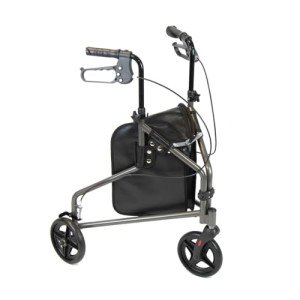This company has no active jobs
0 Review
Rate This Company ( No reviews yet )
About Us
See What Rollator For Walking Tricks The Celebs Are Utilizing

Understanding Rollators for Walking: A Comprehensive Guide
Rollators are an essential mobility aid that boosts the liberty and independence of those with minimal walking capabilities. They are developed not only to use stability and assistance however likewise to encourage mobility and engagement in daily activities for people of all ages. This post digs deep into the world of rollators, supplying insights into their features, benefits, types, upkeep, and crucial factors to consider when picking the most appropriate design.
What is a Rollator?
A rollator is a mobile walking aid geared up with 4 wheels, handgrips, a seat, and typically includes additional functions such as storage baskets and brakes. Unlike conventional walkers, which require the user to lift them off the ground, rollators can be pushed along as the user strolls, making them especially useful for individuals with limited strength or balance.
Key Features of Rollators
Rollators include several functions that improve their use:
- Wheels: Most rollators include swivel or fixed wheels for much better maneuverability inside and outdoors.
- Brakes: Hand brakes permit users to manage their speed and stop securely.
- Seat: Many rollators supply an integrated seat for users to rest when required.
- Lightweight Frame: Constructed from lightweight products, rollators are simple to raise and transport.
- Adjustable Height: Most rollators enable height modifications to accommodate the user’s stature.
Benefits of Using a Rollator
Utilizing a rollator uses many advantages, especially for seniors and people with mobility obstacles. These may include:
- Improved Stability: Rollators supply a stable base that helps prevent falls.
- Increased Mobility: Users can move about more easily, whether indoors or outdoors.
- Boosted Independence: With a rollator, users can carry out daily jobs without requiring assistance.
- Practical Seating: The accessibility of a seat allows users to rest whenever they feel tired.
Types of Rollators
When considering which rollator to choose, it’s important to acknowledge the numerous types offered. The main classifications consist of:
- Standard Rollators: Typically have 4 wheels and a seat, ideal for a lot of indoor and outdoor environments.
- Heavy-Duty Rollators: Designed for larger individuals, these rollators have actually strengthened frames and greater weight capabilities.
- Three-Wheel Rollators: These provide a more lightweight and compact option, making them perfect for narrower spaces.
- Foldable Rollators: Convenient for transport, these designs can be quickly collapsed and saved when not in use.
| Kind of Rollator | Description | Best For |
|---|---|---|
| Standard Rollator For Walking (22 blog article) | Four wheels, seat, numerous choices. | General use, indoor and outdoor. |
| Heavy-Duty Rollator | Strengthened for greater weight capacity. | Larger people requiring additional support. |
| Three-Wheel Rollator | Compact and lightweight, simple to maneuver. | Limited space and indoor use. |
| Foldable Rollator | Collapsible for easy transport. | Frequent tourists or caregivers. |
How to Choose the Right Rollator
Picking the best rollator involves thinking about several factors to fulfill the person’s specific needs:
- Weight Capacity: Ensure the rollator can support the user’s weight.
- Height Adjustability: Look for designs that can be adapted to the user’s height for ideal convenience.
- Features Needed: Consider whether additional functions like baskets, trays, or hand brakes are necessary.
- Meant Use: Determine if the rollator will be mostly used indoors, outdoors, or both.
Upkeep Tips for Rollators
To extend the life-span and functionality of a rollator, regular maintenance is important. Here are some helpful ideas:
- Check Brakes: Regularly test brakes to ensure they engage effectively.
- Examine Wheels: Look for indications of wear and tear; wheels need to roll smoothly.
- Clean Regularly: Wipe down the frame and components to prevent dirt buildup.
- Tighten Bolts: Periodically check and tighten up any loose bolts or screws.
Often Asked Questions (FAQs)
1. Can rollators be utilized on irregular surfaces?
Yes, lots of rollators are designed with larger wheels or specialized treads to handle unequal surfaces. However, users need to exercise caution and guarantee they feel steady when navigating such surfaces.
2. How do I determine the proper height for a rollator?
When standing directly, the deals with of the rollator ought to align with the user’s wrist when their arms are unwinded at their sides. This position ensures comfortable use.
3. Do I need a prescription to acquire a rollator?
No, rollators can be purchased without a prescription. Nevertheless, seeking advice from a health care specialist can be advantageous to identify the best alternative based upon individual requirements.
4. Are rollators covered by insurance?
Coverage for rollators can differ based on the type of insurance strategy. Many Medicare plans offer coverage for some kinds of walkers, including rollators. It’s recommended to talk to the insurance supplier directly.
Rollators for walking considerably boost the lives of lots of people facing mobility challenges. Providing stability, independence, and ease of movement, they serve as important tools for preserving an active lifestyle. Understanding the different types, functions, and how to keep them in good condition can empower users in making notified decisions. As mobility requirements vary greatly from individual to individual, it is important to select a rollator that best meets individual requirements and enhances quality of life.
